Patriotic poet Katharine Lee Bates was born and raised on Cape Cod, a narrow wisp of seaside sand where the only elevation comes from dunes that shift with wind and tide.
Later a professor at Wellesley College in Massachusetts, Bates traveled 2,000 miles across the vast continent to teach in Colorado in the summer of 1893.
She was stunned by the eternal solidity of the Rocky Mountains and inspired almost instantly to record the incredible experience of seeing the United States from new heights.
Bates wrote “America the Beautiful.”
MEET THE AMERICAN WHO WAS REVERED AS THE ‘PATRON SAINT’ UNTIL HE WAS CANCELED: LENNI LENAPE CHIEF TAMMANY
The words flowed frantically after she reached the summit of Pike’s Peak, 14,000 feet above sea level, and peered down in “rapture” and “ecstatic gaze,” she later wrote, at the stunning spectacle.
“O beautiful for spacious skies/For amber waves of grain/For purple mountain majesties/Above the fruited plain!” read the opening lines of her American panegyric.
Katharine Lee Bates, a poet and professor at Wellesley College, is best known as the author of “America the Beautiful,” which she wrote after a trip to Pike’s Peak in 1893. She was born on Aug. 12, 1859, in Falmouth, Massachusetts, and died on March 28, 1929, in Wellesley, Massachusetts. (Public Domain)
Her words today are deeply embedded in the soul of a nation.
“It was then and there, as I was looking out over the sea-like expanse of the fertile country spreading away so far under those ample skies, that the opening lines of the hymn floated into my mind,” Bates told the Boston Evening Transcript in 1904.
“Looking out over the sea-like expanse of the fertile country spreading away so far under those ample skies … the opening lines of the hymn floated into my mind.”
“When we left Colorado Springs, the four stanzas were penciled in my notebook, together with other memoranda, in verse and prose, of the trip.”
Originally titled “Pike’s Peak,” her poem was published on July 4, 1895, in “The Congregationalist,” a Boston-based Christian magazine. The power of its message quickly spread. Numerous efforts followed to put the words to music.
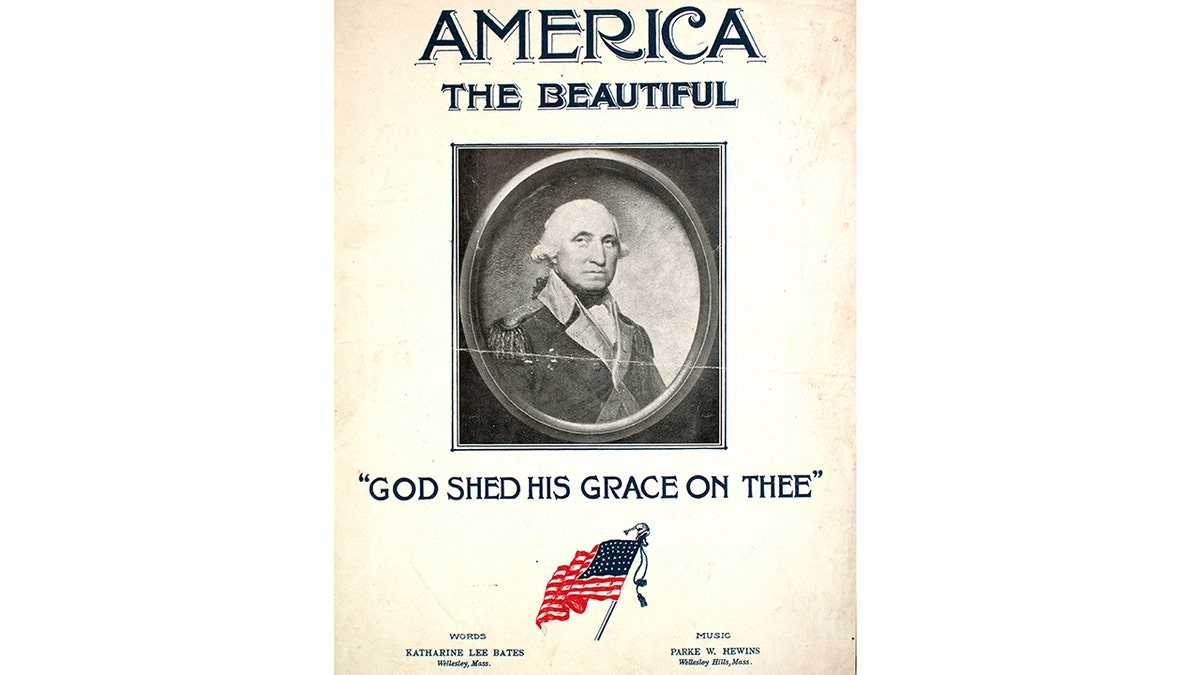
Sheet music cover image of the song “America the Beautiful: ‘God Shed His Grace on Thee,’” with original authorship notes reading, “Words by Katharine Lee Bates, Wellesley, Mass; Music by Parke W. Hewins, Wellesley Hills, Mass.,” 1917. The first line reads, “O beautiful for spacious skies/For amber waves of grain,” and the illustration artist is listed as “None.” (Sheridan Libraries/Levy/Gado/Getty Images)
Her poem was paired with a tune in 1910 by church composer Samuel Augustus Ward of Newark, New Jersey, creating the soaring version of the national spiritual known today.
“America the Beautiful” may best be remembered for its impassioned description of the physical beauty of the landscape.
MEET THE AMERICAN WHO WROTE ‘THE BATTLE HYMN OF THE REPUBLIC’
But it is actually a spiritual call to unity. A prayer.
Bates herself called it a hymn.
She wrote it in the aftermath of carnage in an era when progressive academics celebrated foundational principals of faith rather than railed against them.

John Legend sings “America The Beautiful” before the start of Super Bowl XLIX between the New England Patriots and Seattle Seahawks on Feb. 1, 2015, at the University of Phoenix Stadium in Glendale, Arizona. (Focus on Sport/Getty Images)
“She was a child of the Civil War. She knew the danger of seeing a country so polarized,” Bates biographer Nancy Churnin, author of the book for young readers, “For Spacious Skies,” told Fox News Digital.
“Her dream was to write a poem to remind us that we are one American family from sea to shining sea.”
‘Rock’d in a clamshell’
Katharine Lee Bates was born in the coastal community of Falmouth, Massachusetts, on Aug. 12, 1859.
“Rock’d in a clamshell,” she once noted of her infancy.

The childhood home of Katherine Lee Bates, author of “America the Beautiful,” in Falmouth, Massachusetts. (Elisa Rolle, licensed under Creative Commons)
Father William Bates was the minister of the Congregational church in the center of town. Mother Cornelia Frances (Lee) Bates boasted a prominent education for a woman of the era. Both parents came from longtime New England families.
William Bates, suffering from a tumor in his spine, died just weeks after she was born.
“You must compose yourself and be calm. You must trust in the Lord and be reconciled to his will. He will provide for you.”
As his last official act, Rev. Bates baptized his daughter.
“You must compose yourself and be calm,” the minister reportedly said to his wife while on his deathbed. “You must trust in the Lord and be reconciled to his will. He will provide for you.”
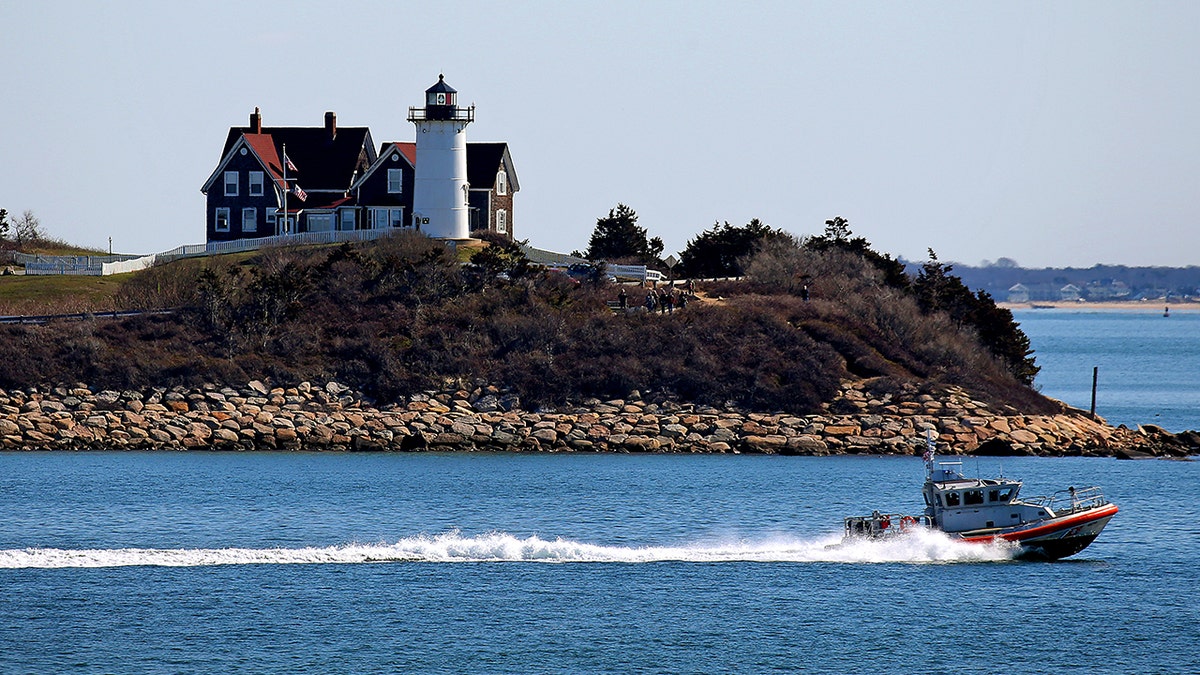
A U.S. Coast Guard vessel makes its way in front of the Nobska Point Light in Falmouth, Massachusetts. The seaside community on Cape Cod is the birthplace of Katharine Lee Bates, who wrote “America the Beautiful.” The town boasts many tributes to the famous daughter of Falmouth. (David L. Ryan/The Boston Globe via Getty Images)
His death left Katharine’s “brilliant mother and literary aunt, both Mount Holyoke Seminary graduates, to raise four young children,” wrote Bates biographer Melinda Ponder, in a speech delivered at Wellesley College in 2016.
“This sea-faring village with many impoverished widows and children, where it was ‘share and share alike,’ as her mother said, showed Katharine what a true community was like,” Ponder also wrote.
MEET THE AMERICAN WHO FOUNDED FATHER’S DAY, SONORA SMART DODD, DAUGHTER OF CIVIL WAR VETERAN AND DEVOTED DAD
The tragedy of the Civil War lingered over Bates’ life. The little fishing town of Falmouth, then numbering just 2,500 residents, lost 19 men in the war.
She was just five years old when President Abraham Lincoln was assassinated. Yet she remembered the grief the rest of her life — her mother’s tears and her widow’s black shawl hung in mourning at their church.

An engraving depicts John Wilkes Booth escaping after shooting President Abraham Lincoln at Ford’s Theatre in Washington, D.C. (iStock)
“The nation’s sorrow, I felt my sorrow,” Bates wrote years later of the childhood memory.
Yet Bates prospered as a child. She read voraciously, with Louisa May Alcott, Sir Walter Scott and Charles Dickens among her favorite writers.
“Bates entered the second class of students at new Wellesley College in 1876, where she was known as ‘Katie of ’80′ and served as class president and poet.”
She entered the second class of students at new Wellesley College in 1876, where she was known as “Katie of ’80.” She served as class president and poet.
The school was founded, among other purposes, to create a new generation of teachers to help replace the thousands of male teachers killed and crippled during the Civil War.

The cover of one of Bates’ earlier poems, “Goody Santa Claus,” published in 1889. The poem tells the tale of Christmas from the point of view of Santa’s wife, Goodwife “Goody” Claus. The story helped propel the concept of Mrs. Claus in popular culture. (Public Domain)
Bates gained the attention of school founder Henry Durant.
“He did all he could to encourage and help Katharine get started on her literary career,” wrote Ponder, the author of “Katharine Lee Bates: From Sea to Shining Sea.”
Through Durant, Bates met or worked with literary icons Henry Wadsworth Longfellow and William Dean Howells.
Years later, as a prominent Wellesley College educator, she mentored a future titan of American letters: young poet Robert Frost.

Katharine Lee Bates, right, and her partner Katharine Coman, left, a fellow Wellesley professor. Bates is the author of “America the Beautiful.” Coman was also a distinguished writer and scholar and, by one account, the first female statistics professor in the United States. (Public Domain)
She enjoyed a long relationship with fellow Wellesley College professor Katharine Coman — a pioneering female academic in economics and statistics.
The two lived together for years in an arrangement referred to during that era as a “Boston marriage.”
Bates traveled across the country to teach in Colorado Springs in the summer of 1893.
The trip took her through Niagara Falls, across vast fruiting fields of a booming agricultural nation and to the rapidly growing city of Chicago, where she attended the World’s Fair.

View looking south across the west end of the Great Basin at the Chicago World’s Columbian Exposition or Chicago World’s Fair, 1893. Katharine Lee Bates, author of “America the Beautiful,” visited the fair and its White City. It inspired her image of “alabaster cities” referenced in the patriotic anthem. (Chicago History Museum/Getty Images)
Among the most notable exhibits was its White City.
Bates was reminded of the fair’s gleaming alabaster city later that summer as she stood atop Pike’s Peak and penned her magnificent poem.
‘Who more than self their country loved’
The memorable beauty of the national landscape captured in “America the Beautiful” is only one part of its story.
Bates, perhaps more powerfully, captured the spiritual beauty of a “new nation conceived in liberty, and dedicated to the proposition that all men are created equal,” as President Lincoln said so powerfully beside the battle dead of Gettysburg when the future poet was just four years old.
The United States suffered human failings — including the horrific carnage of disunity that raged in Bates’ childhood and shaped her destiny.
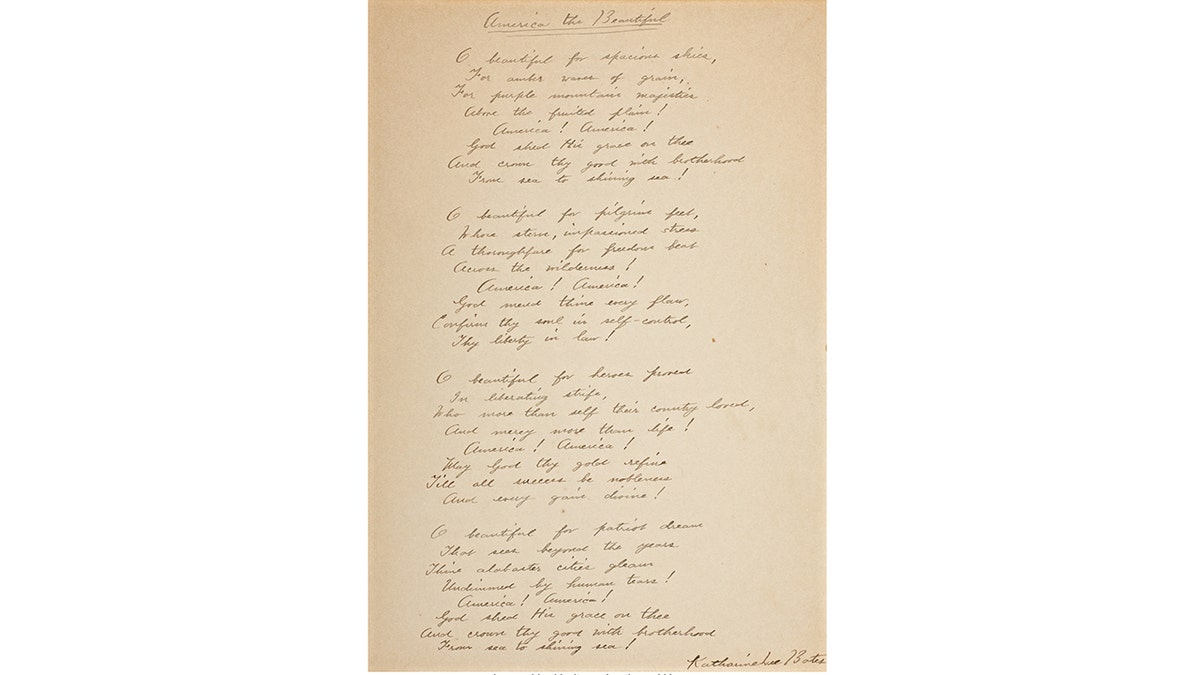
Katharine Lee Bates would often write out the lyrics to “America the Beautiful” for friends, family and fans. This handwritten copy of the lyrics is signed by Bates (date unknown). (Heritage Auctions)
Yet she still believed — as Lincoln did — that “God shed His grace on thee.”
She famously described the American landscape only in her first stanza. The other three stanzas are tributes to the power of faith to unite a vast nation.
O beautiful for spacious skies/For amber waves of grain,
For purple mountain majesties/Above the fruited plain!
America! America!/God shed his grace on thee
And crown thy good with brotherhood/From sea to shining sea!
O beautiful for pilgrim feet/Whose stern impassioned stress
A thoroughfare of freedom beat/Across the wilderness!
America! America!/God mend thine every flaw,
Confirm thy soul in self-control/Thy liberty in law!

A woman takes a picture at the top of Pike’s Peak mountain in the Front Range of the Rocky Mountains within Pike National Forest, 10 miles west of Colorado Springs, Colorado, on June 8, 2013. Cape Cod native and poet Katharine Lee Bates was inspired to write “America the Beautiful” after she cast an “ecstatic gaze” upon the land from the top of Pike’s Peak in 1893. (Joe Klamar/AFP via Getty Images)
O beautiful for heroes proved/In liberating strife.
Who more than self their country loved/And mercy more than life!
America! America!/May God thy gold refine
Till all success be nobleness/And every gain divine!
O beautiful for patriot dream/That sees beyond the years
Thine alabaster cities gleam/Undimmed by human tears!
America! America!/God shed his grace on thee
And crown thy good with brotherhood/From sea to shining sea!
The second stanza pays homage to pilgrims — both the Pilgrims of 1620 and the immigrants who followed — and the necessity of morality in a world of temptation.
MEET THE AMERICAN WHO GAVE THE NATION OUR THANKSGIVING ORIGIN STORY: PILGRIM EDWARD WINSLOW
The Mayflower Pilgrims first stepped on shore on Bates’ native Cape Cod in the autumn of 1620 before settling a few miles north in Plymouth.
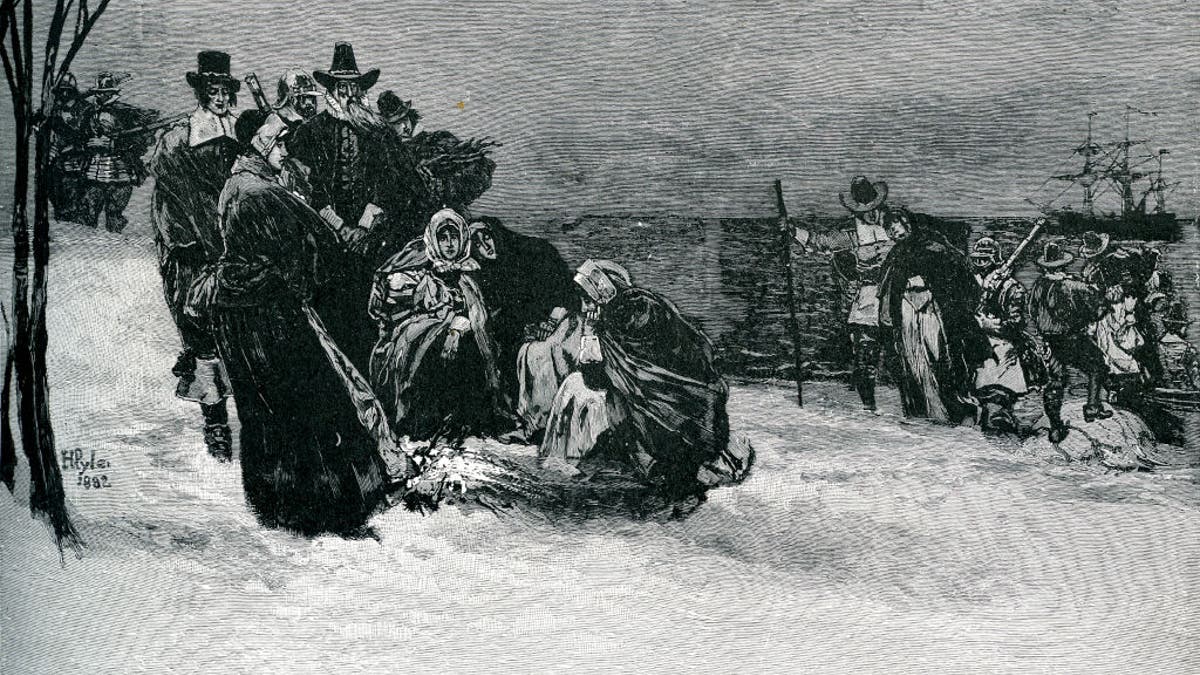
Landing of the Mayflower pilgrims at Plymouth Rock, Cape Cod, Massachusetts, 1620. Illustration by Howard Pyle, 1882, in “Howard Pyle’s Book of the American Spirit.” Artist Howard Pyle. The Pilgrims first set foot in Plymouth on Dec. 16, 1620. (Culture Club/Bridgeman via Getty Images)
“History records no nobler venture for faith and freedom than that of this Pilgrim band,” reads the tomb on the Pilgrims overlooking Plymouth Harbor today.
Bates surely grew up inspired by their dauntless faith in the face of death.
Musician Ray Charles sang one of the most memorable versions of “America the Beautiful,” which he began with the third stanza.
The passage pays tribute to those who so believed in the grace of God that they gave their lives for their homeland “in liberating strife.”
The passage echoes the words of another spiritual patriotic anthem, written by another Massachusetts woman, “The Battle Hymn of the Republic,” by Julia Ward Howe.

President Ronald Reagan leans over and thanks singer Ray Charles on Aug. 23, 1984. Charles sang “America the Beautiful” at the GOP Convention in Dallas, Texas. Nancy Reagan is on the left. (Getty Images)
“As he died to make men holy let us die to make men free,” Howe wrote in her more martial, combative poem, written 30 years earlier as the Civil War raged.
Bates’ poem ends with an impassioned plea to “crown thy good with brotherhood” — a call to unity in a nation uniquely comprised of people from all corners of the world.
“It really is a prayer. She’s praying and asking for God’s help to keep the country united.”
“It’s not jingoistic patriotism. She recognized the nation had flaws,” Ponder, the biographer, told Fox News Digital.
“But it really is a prayer. She’s praying and asking for God’s help to keep the country united.”
Remembered from sea to shining sea
Katharine Lee Bates died of pneumonia on March 28, 1929, in Wellesley.
She was 69 years old.

Wellesley College professor Katharine Lee Bates is shown sitting in masters regalia in front of a fireplace with a dog, early 19th century. (Heritage Auctions)
She’s buried in Oak Grove Cemetery in Falmouth. Katharine Lee Bates Road is a prominent thoroughfare in the center of town.
Shining Sea Bike Path allows cyclists and Cape Cod tourists to pedal leisurely past seagrass and views of the Atlantic to Woods Hole.
The Falmouth port village is famous internationally for the Woods Hole Oceanographic Institute and treasured locally for its ferry service to the resort islands of Martha’s Vineyard and Nantucket.

Original tombstone of Cornelia F. Lee, mother of Katharine Lee Bates and wife of William Bates, along with Jane Bates, Katharine Bates’ sister, and Katharine Lee Bates herself, in Oak Grove Cemetery, Falmouth, Massachusetts. (Elisa Rolle, licensed under Creative Commons)
Bates is honored with numerous buildings and memorials at Wellesley College, and with elementary schools in both Wellesley and Colorado Springs.
She was inducted into the Songwriters Hall of Fame in 1970.
CLICK HERE TO SIGN UP FOR OUR LIFESTYLE NEWSLETTER
Bates lived long enough to see her words become a globally recognized anthem of a grateful American nation.
It’s deeply rooted in the spiritual foundations of the United States, as solid as the Rocky Mountains, as hopeful as its gleaming new cities, as beautiful as the idyllic sea shores of her native Cape Cod, where the Pilgrims first “a thoroughfare to freedom beat.”
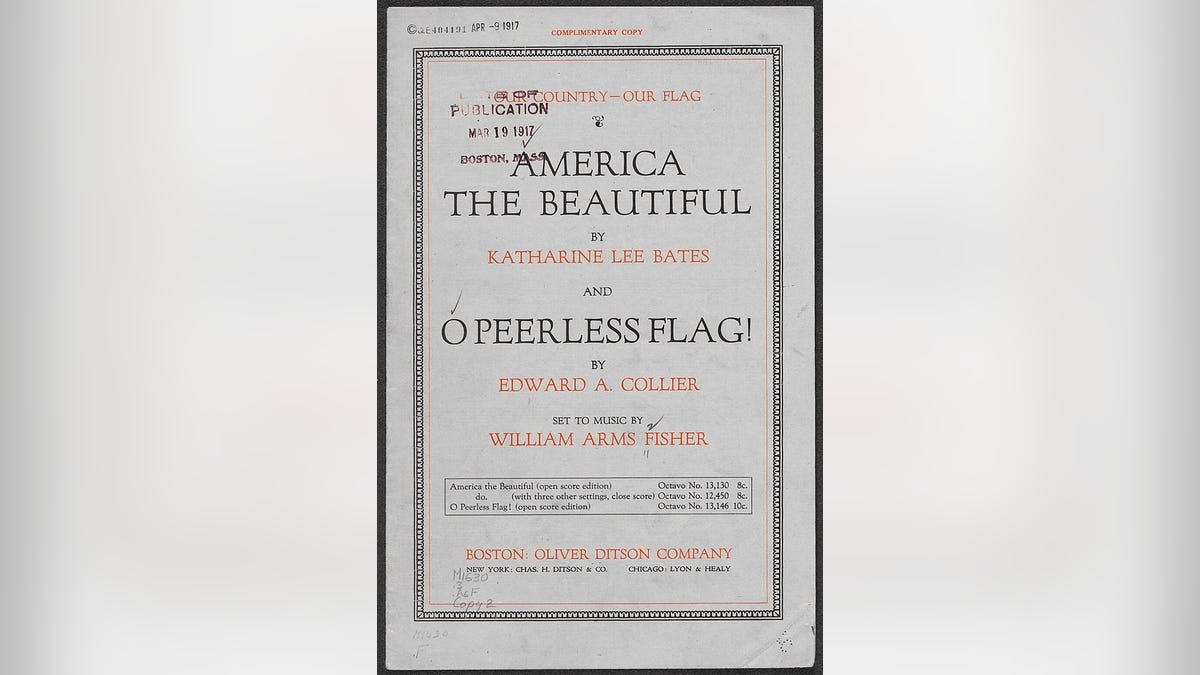
Cover of an early copy of “America the Beautiful” by Katharine Lee Bates and “O Peerless Flag!” by Edward Collier, set to music by William Arms Fisher, dated 1917. (Public Domain)
Bates considered her “greatest tribute as a poet” an honor from overseas, according to Ponder.
It came on Nov. 11, 1918 — Armistice Day — as American soldiers in France received news that World War I was over.
“America! America!/God shed his grace on thee/And crown thy good with brotherhood/From sea to shining sea!”
“A battalion of American soldiers — exhausted, wounded and forever scarred, who had risked their lives for the country they loved — stood up and got themselves into military formation,” wrote Ponder.
For more Lifestyle articles, visit www.foxnews.com/lifestyle
The men, with “voices weak from poison gas and hunger,” began to sing in celebration.
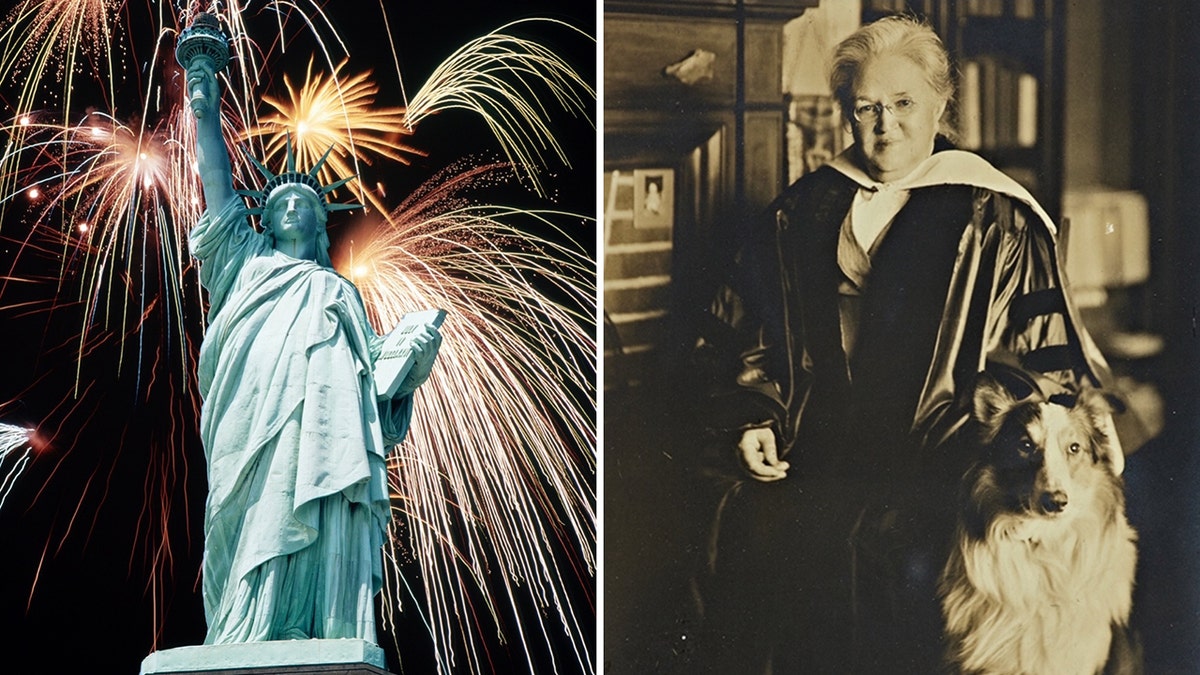
The Statue of Liberty amid Independence Day fireworks — and Katharine Lee Bates, author of “America the Beautiful.” (Getty Images/Heritage Auctions)
“Overwhelmed with shock, grief and incredulous joy, they did not want a song about war. They wanted to celebrate the beauty and idealism of their beloved land.”
CLICK HERE TO GET THE FOX NEWS APP
As Americans, including Bates, joyfully celebrated the end of the war back home, these boys sang as one in France: “America! America!/God shed his grace on thee/And crown thy good with brotherhood/From sea to shining sea!”
To read more stories in this unique “Meet the American Who…” series from Fox News Digital, click here.




